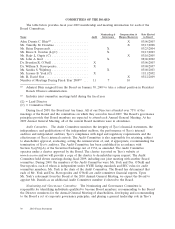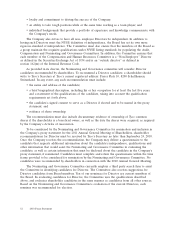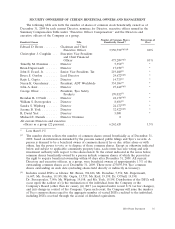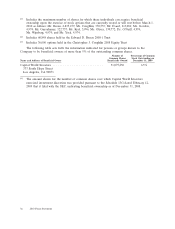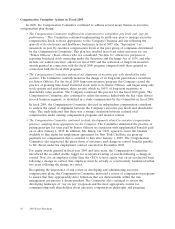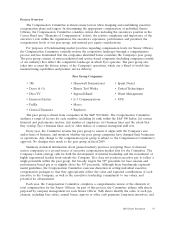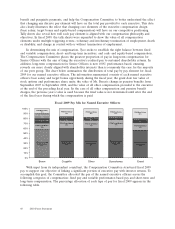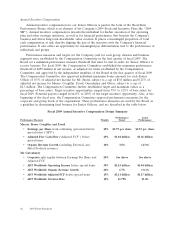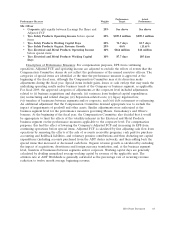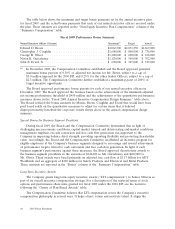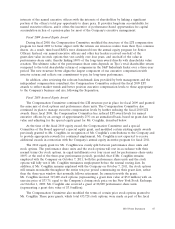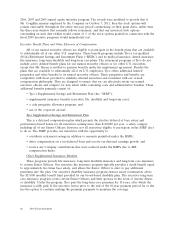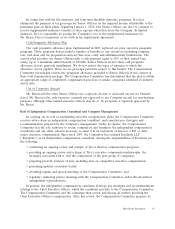ADT 2009 Annual Report Download - page 57
Download and view the complete annual report
Please find page 57 of the 2009 ADT annual report below. You can navigate through the pages in the report by either clicking on the pages listed below, or by using the keyword search tool below to find specific information within the annual report.EXECUTIVE OFFICER COMPENSATION
Compensation Discussion and Analysis
Introduction
The Compensation Discussion and Analysis section of this Proxy Statement discusses the role of
the Compensation and Human Resources Committee (the ‘‘Compensation Committee’’) in establishing
the objectives of the Company’s executive compensation plans; the Compensation Committee’s
executive compensation philosophy, and the application of this philosophy to Tyco’s executive
compensation plans. It also provides an analysis of the compensation design, and the decisions the
Compensation Committee made in fiscal 2009 with respect to the elements of compensation and the
total compensation paid to the five ‘‘named executive officers’’ of Tyco: Edward D. Breen, the
Chairman and Chief Executive Officer; Christopher J. Coughlin, the Executive Vice President and
Chief Financial Officer; George R. Oliver, President, Safety Products and Electrical & Metal Products;
Naren K. Gursahaney, President, ADT Worldwide; and John E. Evard, Jr., Senior Vice President and
Chief Tax Officer.
In designing the Company’s executive compensation programs, the Compensation Committee is
guided by its philosophy that holds that the programs must: (i) reinforce Tyco’s business objectives and
the creation of long-term shareholder value; (ii) provide for performance-based reward opportunities
that support growth and innovation without encouraging or rewarding excessive risk; (iii) align the
interests of executives and shareholders by weighting a significant portion of compensation on sustained
shareholder returns through long-term performance programs; (iv) attract, retain and motivate key
executives by providing competitive compensation with an appropriate mix of fixed and variable
compensation, short-term and long-term incentives, and cash and equity-based pay; and (v) recognize
and support outstanding individual performance and behaviors that demonstrate our core values—
Integrity, Excellence, Teamwork and Accountability.
Fiscal 2009 Summary
Overall, fiscal 2009 was a challenging year for the Company, as the global economic recession
adversely affected the Company’s businesses across nearly all industries and regions. The Company’s
revenue decreased by nearly $3.0 billion, or 14.7%, compared to 2008, and goodwill and intangible
asset impairment charges were largely responsible for a U.S. GAAP operating loss of $1.5 billion for
the year, compared to operating income of $1.9 billion in 2008. In response to the downturn,
management implemented a number of measures to contain general and administrative costs, including
compensation costs. Additionally, management identified key priorities that would best position the
Company to succeed in a rapidly deteriorating economy, and emerge as a stronger, more efficient
organization when the economy improved. Besides identifying ways to further reduce costs through
restructuring activities and other initiatives, management focused on strengthening the balance sheet
and on improving cash flow to gain greater operating flexibility. To reinforce these priorities the
Compensation Committee in May 2009 created an incentive program, effective at the business segment
level, to reward the attainment of performance metrics related to cash flow improvement. Through
these efforts, the Company increased its cash flow from operating activities over the fiscal 2008 level.
Thus, while the Company addressed the short-term challenges presented by adverse economic
conditions, it also took actions to enhance balance sheet flexibility and enable continued investment in
long-term growth opportunities.
2010 Proxy Statement 37





